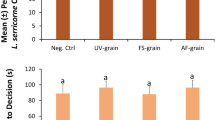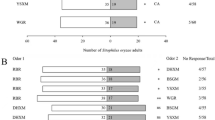Abstract
Laboratory experiments were conducted to study the behavioral activity of grain-derived volatiles as attractants and pheromone synergists forSitophilus oryzae, an internal-feeding pest of sound grain, andTribolium castaneum, an external-feeding pest of damaged grains and flour. Behavioral studies with two-choice pitfall bioassays determined that the fresh grain volatiles valeraldehyde, maltol, and vanillin were attractive toS. oryzae at various doses, butT. castaneum were not attracted to any dose of any of these three compounds. When oils from pressed grains were bioassayed, sesame oil was significantly repellent and oat and wheat germ oils were attractive toS. oryzae. However, rice, soybean, oat, wheat germ, and corn oils were all attractive toT. castaneum. A commercial food product composed primarily of soybean oil and wheat germ was highly attractive toT. castaneum, but elicited no response fromS. oryzae. A combination of the three grain volatiles valeraldehyde, maltol, and vanillin with the synthetic pheromone sitophinone was more attractive toS. oryzae than either the pheromone alone or the tripartite grain volatile mix. Similarly, a combination of the commercial food product with the pheromone 4,8-dimethyldecanal was more attractive toT. castaneum than either food alone or pheromone alone. Behavioral responses to grain volatiles may reflect the ecological niche of the granivore:S. oryzae colonizes sound grain and is attracted to volatiles characteristic of fresh grain, whileT. castaneum utilizes damaged or deteriorated grains and responds best to oils characteristic of damaged or fungus-infested grain. Synergism of food odors and pheromones suggests that more effective traps can be devised for management of these pest insects.
Similar content being viewed by others
References
Barak, A.V., andBurkholder, W.E., 1985. A versatile and effective trap for detecting and monitoring stored-product Coleoptera.Agric. Ecosyst. Environ. 12:207–218.
Borden, J.H. 1982. Aggregation pheromones, pp. 74–139,in J.B. Mitton and K.B. Sturgeon (eds.). Bark Beetles in North American Conifers: A System for the Study of Evolutionary Biology. University of Texas Press, Austin.
Burkholder, W.E. 1990. Practical use of pheromones and other attractants for stored-product insects, pp. 497–516,in R.L. Ridgway, R.M. Silverstein, and M.N. Inscoe (eds.). Behavior-Modifying Chemicals for Insect Management: Applications of Pheromones and Other Attractants. Marcel Dekker, New York.
Christensen, C.M., andKaufman, H.H. 1969. Grain Storage, The Role of Fungi in Quality Loss. University of Minnesota Press, Minneapolis, 153 pp.
Dickens, J.C. 1989. Green leaf volatiles enhance aggregation pheromone of boll weevil,Anthonomus grandis.Entomol. Exp. Appl. 52:191–203.
Dickens, J.C., Jang, E.B., Light, D.M., andAlford, A.R. 1990. Enhancement of insect pheromone responses by green leaf volatiles.Naturwissenschaften 77:29–31.
Landolt, P.J. 1989. Attraction of the cabbage looper to host plants and host plant odor in the laboratory.Entomol. Exp. Appl. 53:117–124.
Landolt, P.J., andHeath, R.R. 1990. Sexual role reversal in mate-finding strategies of the cabbage looper moth.Science 249:1026–1028.
Levinson, H.Z., andMori, K. 1983. Chirality determines pheromone activity for flour beetles.Naturwissenschaften 70:190–192.
Lindsley, E.G. 1944. Natural sources, habitats, and reservoirs of insects associated with stored food products.Hilgardia 16:187–224.
Liu, S.-H., Norris, D.M., andMarti, E. 1988. Behavioral responses of female adultTrichoplusia ni to volatiles from soybeans versus a preferred host, lima bean.Entomol. Exp. Appl. 49:99–109.
Maga, J.A. 1978. Cereal volatiles, a review.J. Agric. Food Chem. 26:175–178.
Mikolajczak, K.L., Zilkowski, B.W., Smith, C.R. Jr., andBurkholder, W.E. 1984. Volatile food attractants forOryzaephilus surinamensis (L.) from oats.J. Chem. Ecol. 10:301–309.
Nara, J.M., Lindsay, R.C., andBurkholder, W.E. 1981. Analysis of volatile compounds in wheat germ oil responsible for an aggregation response inTrogoderma glabrum larvae.Agric. Food Chem. 29:68–72.
Phillips, J.K., andBurkholder, W.E. 1981. Evidence for a male-produced aggregation pheromone in the rice weevil.J. Econ. Entomol. 74:539–542.
Phillips, J.K., Walgenbach, C.A., Klein, J.A., Burkholder, W.E., Schmuff, N.R., andFales, H.M. 1985. (R S)-5-Hydroxy-4-methyl-3-heptanone: Male-produced aggregation pheromone ofSitophilus oryzae (L.) andS. zeamais Motsch.J. Chem Ecol. 11:1263–1274.
Phillips, T.W., West, J.R., Foltz, J.L., Silverstein, R.M., andLamer, G.N. 1984. Aggregation pheromone of the deodar weevil,Pissodes nemorensis (Coleoptera: Curculionidae): Isolation and activity of grandisol and grandisal.J. Chem. Ecol. 10:1417–1423.
Pierce, A.M., Pierce, H.D., Oehlschlager, A.C., andBorden, J.H. 1990. Attraction ofOryzaephilus surinamensis (L.) andOryzaephilus mercator (Fauvel) (Coleoptera: Cucujidae) to some common volatiles of food.J. Chem. Ecol. 16:465–475.
Pierce, A.M., Pierce, H.D., Borden, J.H., andOehlschlager, A.C. 1991. Fungal volatiles: Semiochemicals for stored-product beetles (Coleoptera: Cucujidae).J. Chem. Ecol. 17:581–597.
Raina, A.K., Kingan, T.G., andMattoo, A.K. 1992. Chemical signals from host plant and sexual behavior in a moth.Science 255:592–594.
Sinha, R.N. 1973. Ecology of storage.Ann. Tech. Agric. 22:351–369.
Sinha, R.N., Tuma, D., Abramson, D., andMuir, W.E. 1988. Fungal volatiles associated with moldy grain in ventilated and non-ventilated bin-stored wheat.Mycopathologia 101:53–60.
Suzuki, T. 1980. 4,8-dimethyldecanal: the aggregation pheromone of the flour beetlesT. castaneum andT. confususm (Coleoptera: Tenebrionidae).Agric. Biol. Chem. 44:2519–2520.
Trematerra, P., andGirgenti, P. 1989. Influence of pheromone and food attractants on trapping ofSitophilus oryzae (L.) (Col., Curculionidae): A new trap.J. Appl. Entomol. 108:12–20.
Walgenbach, C.A., Burkholder, W.E., Curtis, M.J., andKhan, Z.A. 1987. Laboratory trapping studies withSitophilus zeamais (Coleoptera: Curculionidae).J. Econ. Entomol. 80:763–767.
Wood, D.L. 1982. The role of pheromones, kairomones, and allomones in the host selection and colonization behavior of bark beetles.Annu. Rev. Entomol. 27:411–446.
Author information
Authors and Affiliations
Rights and permissions
About this article
Cite this article
Phillips, T.W., Jiang, X.L., Burkholder, W.E. et al. Behavioral responses to food volatiles by two species of stored-product coleoptera,Sitophilus oryzae (curculionidae) andTribolium castaneum (tenebrionidae). J Chem Ecol 19, 723–734 (1993). https://doi.org/10.1007/BF00985004
Received:
Accepted:
Issue Date:
DOI: https://doi.org/10.1007/BF00985004




